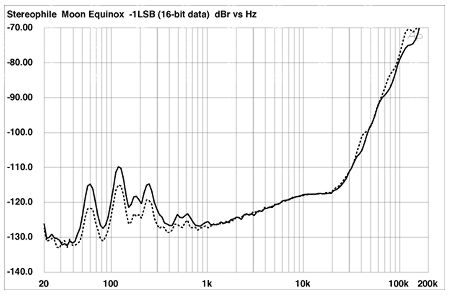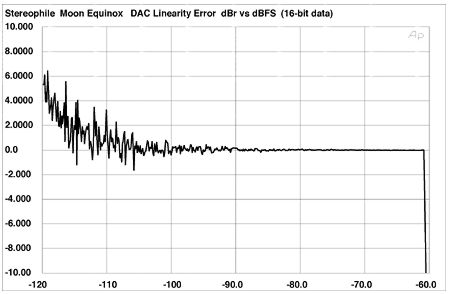| Columns Retired Columns & Blogs |
Simaudio Moon Equinox CD player Measurements
Sidebar 3: Measurements
The Moon Equinox inverted absolute polarity, something that needs to be allowed for in comparisons with other players. Its maximum output level at 1kHz was both to specification and conformed with the "Red Book" Standard at 2.01V RMS, while its output impedance was a usefully low 99 ohms. Error correction was superb, the player coping with gaps in the data spiral up to 1mm without any audible glitches. Only on track 32 on the Pierre Verany test CD, which has 1.5mm gaps, did it stumble.
The Equinox's frequency response was flat within the audioband, with a rolloff of a fraction of a dB apparent at 20kHz (fig.1, top pair of traces). This was due to the filter in the Burr-Brown DAC chip, which is specified as being -3dB at 21.6kHz. It appears that Simaudio's designers chose to implement de-emphasis in the analog domain, which has some theoretical advantages, rather than use the DAC's integral digital-domain de-emphasis. However, as the lower traces in fig.1 reveal, there must be some wrong component values, as a significant error in the mid-treble is apparent. (The expensive Moon Eclipse player suffered from the same problem.) The Equinox will sound a little recessed with those few CDs that are pre-emphasized. Channel separation (not shown) was superb, any crosstalk being buried beneath the noise floor in the midrange, and decreasing to a still excellent 96dB at 20kHz.

Fig.1 Simaudio Moon Equinox, frequency response at -12dBFS into 100k ohms, with de-emphasis (bottom) and without (top). (Right channel dashed, 0.5dB/vertical div.)
Fig.2 shows a spectral analysis of the Moon's analog output, made with a swept 1/3-octave bandpass filter while it played back data representing a dithered 1kHz tone at -90dBFS. The trace peaks at exactly the -90dBFS line, implying negligible low-level linearity error, and there are no harmonic distortion peals evident. However, both channels feature spuriae at the power-supply-related frequencies of 60Hz, 120Hz, and 240Hz. Yes, these are too low in level to be audible, but their presence suggests some small problems in the layout of the printed circuit board. (I could not eliminate these spuriae by experimenting with the grounding between the Equinox and my Audio Precision test set.)

Fig.2 Simaudio Moon Equinox, 1/3-octave spectrum of dithered 1kHz tone at -90dBFS, with noise and spuriae, 16-bit CD data (right channel dashed).
The spuriae can also be seen in a similar, wider-band analysis of the player's output while it decoded data representing a 1LSB DC signal (fig.3). Note the steep rise in the noise floor above 20kHz in this graph, due to the aggressive noiseshaping used by the DAC chip to achieve its excellent audioband resolution. Confirming this resolution, the Equinox's linearity error was less than ±1dB to -110dBFS (fig.4). In fact, the error seen in this graph is almost entirely due to the 16-bit dither noise recorded on the test CD; the BB1703 DAC's performance is better than is required for CD playback. Combined with the Moon's low level of analog noise, the player's reproduction of an undithered 1kHz sinewave at -90.31dBFS was essentially perfect (fig.5). Though a negative DC offset of 10µV can be seen in this graph, this is negligible.

Fig.3 Simaudio Moon Equinox, 1/3-octave spectrum of -1LSB, with noise and spuriae, 16-bit CD data (right channel dashed).

Fig.4 Simaudio Moon Equinox, left-channel departure from linearity, 16-bit CD data (2dB/vertical div.).

Fig.5 Simaudio Moon Equinox, waveform of undithered 1kHz sinewave at -90.31dBFS, 16-bit CD data.
The Moon Equinox featured very low levels of harmonic distortion. Fig.6 is an FFT-derived spectral analysis of its analog output while it drove a full-scale 1kHz signal into a low 4k ohm load. The left channel was a little worse than the right, at 0.0013% vs 0.0007% THD, but both figures are excellent. The highest-level harmonic was the second in both channels, at -99dB (0.001%) left, -106dB (0.0005%) right. Intermodulation distortion was also very low, with just 0.001% of the 1kHz difference component evident when the player drove an equal mix of 19kHz and 20kHz tones into 4k ohms (fig.7). The fairly slow initial rolloff of the digital reconstruction filter results in an aliasing product at 24.1kHz being visible at -86dB in this graph.

Fig.6 Simaudio Moon Equinox, spectrum of 1kHz sinewave, DC-1kHz, at 0dBFS into 8k ohms (linear frequency scale).

Fig.7 Simaudio Moon Equinox, HF intermodulation spectrum, DC-25kHz, 19+20kHz at 0dBFS into 4k ohms, CD data (linear frequency scale).
I assessed the Moon Equinox's rejection of word-clock jitter using the Miller Audio Research analyzer, which runs on a PC fitted with a National Instruments data-acquisition card, while the player decodes a special diagnostic test signal on a CD-R. The result of this test is shown in fig.8. The noise floor is higher than the best CD players I've measured by about 3dB, which will be inconsequential. The jitter level was a very low 172 picoseconds peak-peak, with the data-related components (red numeric markers) close to the background level. The highest-level jitter-related sidebands were low in frequency, at ±15.6Hz and ±31.2Hz (purple "1" and "2" markers), though some higher-frequency sidebands can also be seen (purple "4," "5," and "8").

Fig.8 Simaudio Moon Equinox, high-resolution jitter spectrum of analog output signal (11.025kHz at -6dBFS sampled at 44.1kHz with LSB toggled at 229Hz). Center frequency of trace, 11.025kHz; frequency range, ±3.5kHz.
Overall, the Moon Equinox offers respectable measured performance.—John Atkinson
- Log in or register to post comments



































